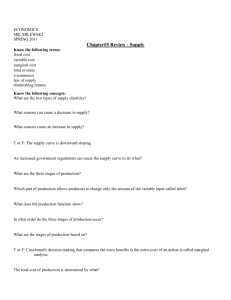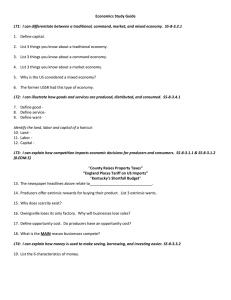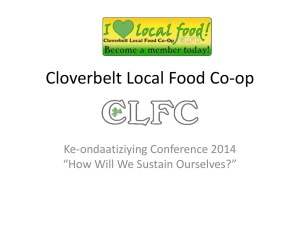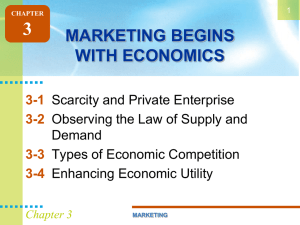Marketing Begins with Economics
advertisement
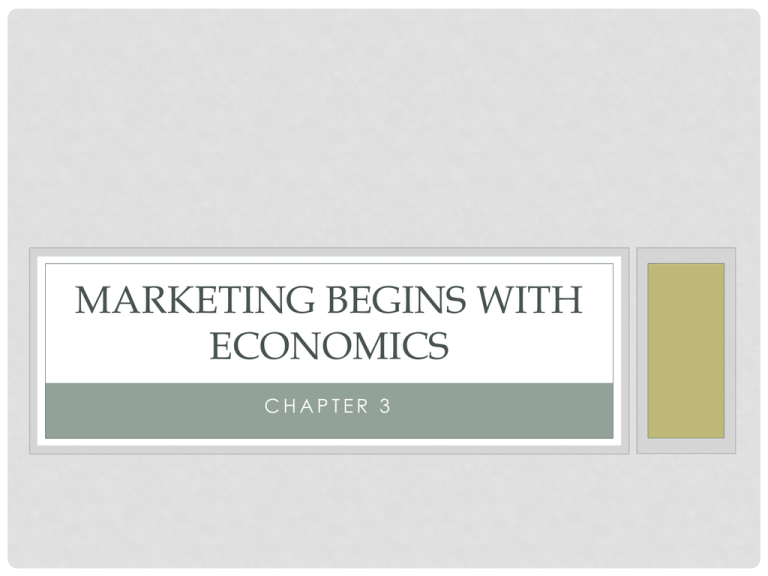
MARKETING BEGINS WITH ECONOMICS CHAPTER 3 4 TYPES OF ECONOMIES 1. Controlled economy The government answers all three economic questions It attempts to own & control important resources and make decision on what is produced and consumed 2. Free Economy (AKA Market Economy) Resources are owned by individuals rather than the government The market provides answers to the 3 questions above No Government involvement 4 TYPES OF ECONOMIES (CON) 3. Mixed Economy • Some goods and services are provided by the government and some by private enterprise 4. America’s Private Enterprise Economy • Private enterprise is based on independent decisions by businesses and consumers with only a limited government role regulating • Resources and production are owned by individuals • Profit motive – obtain the greatest profit • Value – individual view of the worth of a product or service ECONOMICS Macroeconomics Microeconomics 1.Macroeconomics- studies the economic behavior and relationship of an entire society 1.Microeconomics- examines relationships between individual consumers and producers It looks at the big picture – helps determine if society’s resources are being used efficiently Studies the decisions of all consumers and producers and the effects on society Looks at small parts of the total economy Studies how individuals make decisions about what to produce & consume SUPPLY AND DEMAND CURVES Supply Curve Supply Curve- the relationship between price and quantity supplied As price increases, producers will make more As price decreases, fewer are made Demand Curve Demand Curves- the relationship between price and quantity demanded As price increases fewer people buy tickets As price decreases more tickets are sold ^ That relationship is known as the law of demand MARKET PRICE Intersecting supply and demand Market Price – the point at which the demand curve and supply curve intersect The price that Producers will be inclined to use Indicates Market Price and Market Quantity (How much producers will make) TYPES OF ECONOMIC COMPETITION Two characteristics are important to determine the type of economic competition in a specific market 1. The number of firms competing in the market 2. The amount of similarity between the products of competition business There are four forms of economic competion FOUR FORMS OF ECONOMIC COMPETITION 1. Pure competition- few markets with a large # of suppliers with similar products o o o Consumers have a great deal of control over choices and prices Because businesses are unable to offer products that consumers view as unique, they must accept the prices that consumers are willing to pay, or the consumer will buy from another business Some examples include: agricultural products such as corn, rice, wheat, and livestock Each producers products are just like every other producers There are many producers so consumers will have no difficulty finding a business that will sell the product FOUR FORMS OF ECONOMIC COMPETITION 2. Monopoly- a type of market in which one supplier offers a unique product o In this market, the supplier has almost total control, and the consumers will have to accept the suppliers price This occurs because of lack of competition o o o o Governments attempt to control monopolies Some examples are: utility companies that supply electricity, gas or water There is only 1 supplier of each product and it would be very inefficient to have several companies extend gas & water lines to every home Once a home is supplied with utilities it would be easy for them to raise the price, and the consumer would have to pay the higher price – so the government agencies regulate the prices that can be charged FOUR FORMS OF ECONOMIC COMPETITION 3. Oligopolies- few businesses offer very similar products and services o o o o o Ex- The airline industry – there are only a few large airlines competing for national travel in the US One airline will not succeed in increasing prices alone If the airline industry wants higher prices, competing companies need to cooperate in raising their prices as well Depending on the industry the government may attempt to regulate that type of activity, by making it illegal for businesses to work together to control prices Price fixing- is an agreement between business competitors to sell the same product or service at the same price FOUR FORMS OF ECONOMIC COMPETITION 4. Monopolistic Competition- many firms compete with products that are somewhat different o o o o With more competitors and only minor differences, businesses will have very limited control When you have choices as a consumer, you usually select the one providing the most satisfaction at the best value Examples include: restaurants, movie theaters, shopping malls, and athletic stores If your products are similar with other businesses you have to follow the status quo, but if your product is new and unique then you have more freedom to do as you wish QUESTIONS • The USA has many characteristics of a market economy • The cost of resources is different dependent upon what economic system a society uses. • Individuals who purchase products and services to satisfy needs are consumers. • If they work together, businesses in an oligopoly can have an abundance of control over price. • If a business operating as a monopoly that is unregulated by the government, it can charge any price it chooses. The consumer either pays the price set by the business or goes without. • The profit motive is the use of resources to obtain the greatest profit. QUESTIONS • The point where supply and demand for a product or service is equal is called market price. • If consumers believe there is only one product or brand that meets their needs, they will usually be willing to pay a higher price. • If a need or want is particularly important or strong, a consumer might be willing to spend more money to satisfy it. • Marketers are most concerned with microeconomics • Economic resources are classified as natural resources, capital, equipment, and labor. • Value is an individual view of the worth of a product or service.

